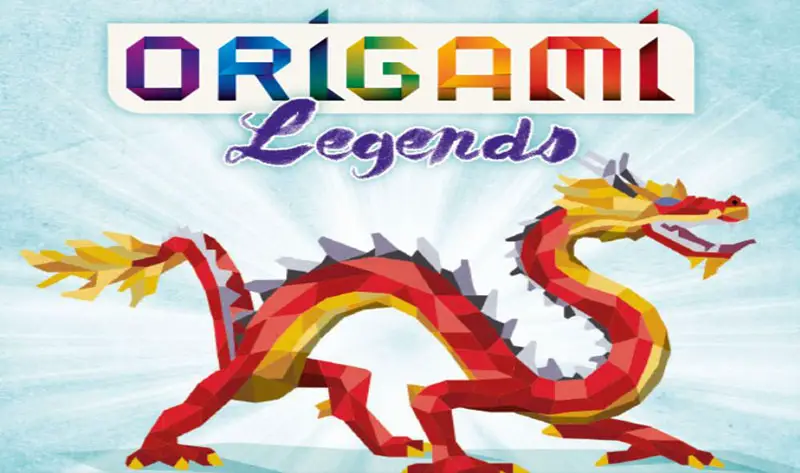
The challenge for the title of "Best Origami Artist" renews!
Using their magical rice paper, the masters give life to astonishing origami: polar and exotic animals, dinosaurs, and even legendary creatures! Do you have what it takes to beat them and impress the jury?
Origami - Legends Is A Stand-alone Game. Origami Is Not Required To Play, But The Two Games Can Be Combined Together!
Components
- 92 Origami cards
- 18 Rice Paper cards.
- A slip of paper to make the Starting Player origami.
- Instructions
Setup
During the game, you will use a number of families and character pairs equal to the number of players (e.g.: with 3 players use 3 families and 3 character pairs, i.e. 3 red characters and the same 3 yellow characters).
You can freely choose which families and characters to use, but take care to always add all the cards of the chosen families, and all characters as pairs, red and yellow.
If you are playing with the polar animals, put the rice paper deck in the middle of the table. Any cards not being used in this game can be returned to the box.
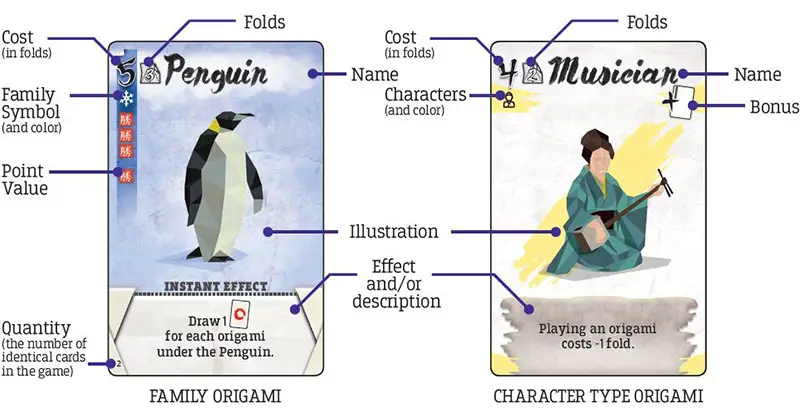
Shuffle the family and character cards together, then deal cards face up to each player, revealing them from the deck one by one, until each player has cards worth a total of at least 10 folds  . Some players may receive more folds than others - that's okay.
. Some players may receive more folds than others - that's okay.
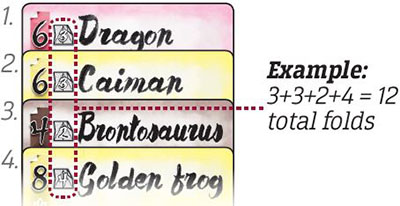
The player dealt the fewest folds become the Starting Player: they take and keep the Starting Player origami for the entire game (ties are broken by drawing lots). Each player takes the cards dealt into their hand, and from now on they are kept secret.
Keep the other cards in a deck in the middle of the table (separate from the rice paper deck, if playing with the polar animals).
Turn over the first four cards and place them face up in a row near the deck. This is the "Draw Line". Leave room for a discard pile.

Game Play
The game is played in turns going clockwise, with the Starting Player going first.
When it is your turn, you must choose one of the following actions:
- Draw Cards
- Play One Origami
After your action is complete, your turn ends. If at this point you now have more than 8 cards in your hand, you must discard the excess so that you have only 8 cards. Play then passes to the next player (on your left).
1. Draw Cards
When you choose this action, take any number of cards from the Draw Line with a total number of folds that is 4 or less. Add those cards to your hand.
When you are done drawing, refill the Draw Line with cards from the deck (face up) so that there are again 4 cards available. If the deck runs out, shuffle the discards and create a new deck (but see "End of the Game").
Example: From the Draw Line above, you could take the T-Rex, or the Ninja and the Macaw. If you wish, you can also take less than 4 folds, such as the Phoenix and the Ninja. Folds you don't take are simply lost.
2. Play One Origami
When you choose this action, you play one Origami from your hand. In order to play a card, you must first pay its cost, in "folds". Each card shows a cost and a number of folds in the corner.
When you play a card, you must discard other cards from your hand worth a total number of folds exactly equal to the cost of the Origami you are playing.
Example: You play the Seal from your hand. To pay its cost (4), you can discard the Reindeer, or the Velociraptor and the Ninja.
Note that you cannot pay by discarding the Dragon and the Velociraptor (or the Dragon and the Ninja) as you would overpay (5 folds) and this is not allowed!
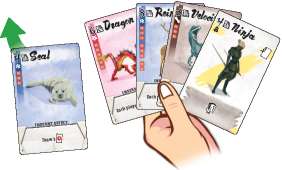
After paying the cost, place the Origami face-up:
- If it is a Family Origami, in front of you in a Collection. See Collections, below.
- If it is a Character Origami, in the middle of the table. See Characters, below.
Collections
When you play a Family Origami, you must add them to your Collections. You can only have two Collections in front of you, and every Family Origami you play must go into one of your two Collections.
Each Collection is a column of Origami cards, with a single Origami "on top". Place each new Origami you play on top of the other cards, but slightly offset so that the left corner of the earlier Origami in that Collection-which shows the Name, Family, and Points Value-is still visible.
At all times, the difference in the size of your two Collections cannot be more than ONE Origami. Your collections must each have the same number of cards or differ by only one card. This means that, except for the first two Origami you play, each time you play an Origami you will cover a previous one. If you cover an Origami that has an Ongoing effect, you lose that effect.
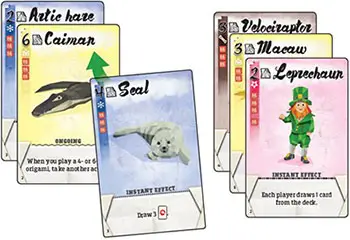
Example: When you play the Seal, you must add it to your left Collection, to balance your two Collections.
You cannot add it to your right Collection, because then the difference in your Collections would be 2 Origami. Sadly, this means that you must lose the Caiman's ongoing effect.
Origami Effects: Every Family Origami has an effect when played. There are three kinds of effects:
Instant Effect: You may use the effect stated on the card immediately when you play it, then the effect ends. Use of Instant Effects is always optional.
Scoring: This Origami only takes effect at the end of the game, during the final scoring.
Ongoing: As long as this Origami is visible on top of one of your Collections, apply the described effect.
Characters

Put the Character into play in the middle of the table. Afterwards, choose 1 Origami from the Draw Line, and play it without paying its cost with folds.
To remind you, this additional bonus is marked with the symbol in the top right corner of each Character card. At the end of your turn, replace the Origami you took from the Draw Line with the top card of the deck.
Characters in play modify the rules of the game for all players. Keep Characters in play separate from the draw line so they are not confused. If the other version of the
Character you are playing is already in play, discard it and replace it with the one you are playing: different Characters may be in play at the same time, but never a yellow/red pair of the same Character.
Note: Each Origami has an effect, described on the card. At first, it will seem like you have a lot to learn but don't be discouraged: the game will flow more smoothly the more you play!
End of the Game
When the deck runs out for the second time, reshuffle the discard pile as normal, then play the current round to the end (until the beginning of the Starting Player's next turn).
Each player now gets one final turn. The last player to take a turn will always be the one sitting to the right of the Starting Player. Now it's time to tally your score!
Your score is equal to the total of the points on all the Origami in your Collections (each = 1 point), plus any points you earn from any Scoring effects on the Origami in the Collections (it does not matter if they have been covered by other Origami), plus any points awarded by Characters in play.
Note: Some Origami (like the Kappa) can award bonus points to a different player than the one who has it in their Collection!
The player with the most points wins! Ties are broken by counting the leftover cards in the tied players' hands-If they are still tied, they share the victory!
Notes on the Origami
Some cards assign VP if you match a required condition: In case of a tie, all tied players score the points (Kappa, Actor, Sumo wrestler, Samurai).
Some cards show these two symbols:

Hand Modifier: As long as it is visible, your hand size limit (normally 8) is modified according to what is shown.

Rice Paper: Draw that many cards from the rice paper deck. If that deck runs out, these cards are momentarily unavailable, and you do not draw any more. Rice paper is not an Origami: Each rice paper card is worth 1 fold  , and can only be used to pay the cost of an Origami.
, and can only be used to pay the cost of an Origami.
When used or discarded, always return rice paper cards to their own deck, never to the discard pile. Rice paper cards are counted towards your hand size limit.
Dinosaurs

Mesosaurus: When you choose action 1. Draw Cards, you may draw a number of folds up to 3 plus any Hand Modifiers you get from your Collections and any Characters in play.
E.g., if a Brontosaurus is visible in your other Collection, draw 3 + 3 = 6 folds.
Exotic Animals

Anaconda: E.g., if one Collection scores 20  and the other 16
and the other 16  , Anaconda awards 4 VP.
, Anaconda awards 4 VP.

Piranha: You can move 1 of your Origami in either of your Collections, wherever you want. If you make an Ongoing Effect visible again, you regain it; but this does not apply to Instant Effects.
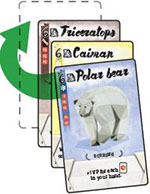

Sloth: You may choose to move another player's Origami. The "bottom of its collection" means as the starting card, see image.
If you make an Ongoing Effect visible again, you regain it; but this does not apply to Instant Effects.
Legendary Creatures

Dragon: Playing the Origami is optional, and you must still pay its cost-it is not free.

Nine-tailed Fox: If you have no cards in your hand, you pass nothing; if you have 1 card, pass it to the left. You still get all cards from the players next to you. With 2 players, pass both cards to the other player.

Oni: If you have less than 2 cards in your hand, discard what you have.

Phoenix: If you have no cards in your hand, you discard nothing, but you still draw 2 cards from the deck.
Polar Animals

Artic Wolf: When you choose action 1. Draw Cards, in addition to the folds you draw, you may discard any number of rice paper cards to draw the same number of cards from the deck.
Characters

Geisha (yellow): This allows you to play the top discard as an Origami, not discard it as folds to pay an Origami's cost.

Merchant: This increases the number of cards in the Draw Line. If you play the yellow Merchant, immediately add 1 card from the deck to the Draw Line.
If the yellow Merchant leaves play, do not discard any of the cards in the Draw Line, but the next time a player refills the Draw Line, refill it only to 4 cards (instead of 5).
Combining Origami Legends and Origami
You can freely combine the families of the two games together. If you use families from Origami, you also have another action available: USE THE SPECIAL ACTION OF AN ORIGAMI-described in the Origami rulebook.
Continue Reading
